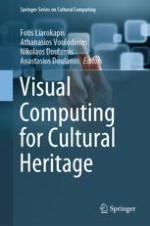This book provides insights into the state of the art of digital cultural heritage using computer graphics, image processing, computer vision, visualization and reconstruction, virtual and augmented reality and serious games. It aims at covering the emergent approaches for digitization and preservation of Cultural Heritage, both in its tangible and intangible facets.
Advancements in Digital Cultural Heritage research have been abundant in recent years covering a wide assortment of topics, ranging from visual data acquisition, pre-processing, classification, analysis and synthesis, 3D modelling and reconstruction, semantics and symbolic representation, metadata description, repository and archiving, to new forms of interactive and personalized presentation, visualization and immersive experience provision via advanced computer graphics, interactive virtual and augmented environments, serious games and digital storytelling.
Different aspects pertaining to visual computing with regard to tangible (books, images, paintings, manuscripts, uniforms, maps, artefacts, archaeological sites, monuments) and intangible (e.g. dance and performing arts, folklore, theatrical performances) cultural heritage preservation, documentation, protection and promotion are covered, including rendering and procedural modelling of cultural heritage assets, keyword spotting in old documents, drone mapping and airborne photogrammetry, underwater recording and reconstruction, gamification, visitor engagement, animated storytelling, analysis of choreographic patterns, and many more.
The book brings together and targets researchers from the domains of computing, engineering, archaeology and the arts, and aims at underscoring the potential for cross-fertilization and collaboration among these communities.
